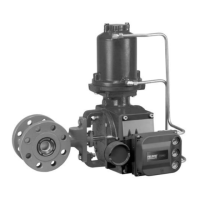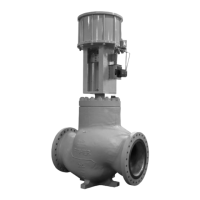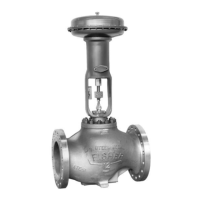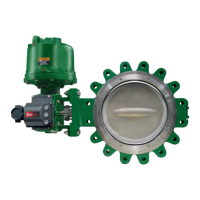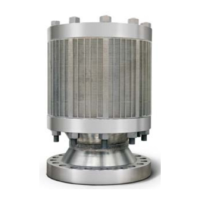Instruction Manual
D101957X012
V150 and V300 Valves
February 2011
6
Stopping Leakage
For PTFE V‐ring packing, leakage around the packing follower and packing flange (keys 17 and 40) can be stopped by
tightening the packing follower nuts (key 20).
If the packing is relatively new and tight on the drive shaft (key 6), and if tightening the packing follower nuts does not
stop leakage, it is possible that the drive shaft is worn or nicked so that a seal cannot be made. If the leakage comes
from the outside diameter of the packing, it is possible that the leakage is caused by nicks, scratches, or corrosion on
the packing box wall.
If the leakage cannot be stopped by the above steps, the packing must be removed and replaced. Inspect the drive
shaft and packing box before installing new packing parts.
Packing Replacement
When replacing the packing, the actuator should not be removed from the valve while the valve is still in the pipeline
or between flanges. Valve/actuator adjustments must be made with the valve out of the pipeline.
Disassembly
1. Isolate the control valve from the line pressure, release pressure from both sides of the valve, and drain the process
media from both sides of the valve. If using a power actuator, shut off all pressure lines to the power actuator,
release pressure from the actuator, and disconnect the pressure lines from the actuator. Use lock‐out procedures to
be sure that the above measures stay in effect while you work on the equipment.
2. Remove line bolting, remove the control valve from the pipeline, and place the actuator/valve assembly on a
protected flat surface with the seal protector ring facing up.
3. Remove the actuator cover. Note the orientation of the actuator with respect to the valve body and the lever
orientation with respect to the valve drive shaft (see figure 8).
WARNING
When the actuator is removed from the valve, the ball/shaft assembly may suddenly rotate, resulting in personal injury. To
avoid injury, carefully rotate the ball to the stable position after the actuator is removed.
CAUTION
When removing the actuator from the valve, do not use a hammer or similar tool to drive the lever or actuator off the valve
shaft. Driving the lever or actuator off the valve shaft could damage the ball, seal, and valve.
If necessary, use a wheel puller to remove the lever or actuator from the valve shaft. It is okay to tap the wheel puller screw
lightly to loosen the lever or actuator, but hitting the screw with excessive force could damage the ball, seal, and valve.
Note
Some actuator designs have a bolt inserted in the lever to spread the clamp on the valve spline shaft. Tightening the bolt expands
the splined lever connection allowing the valve shaft to be removed.
4. When removing the lever (do not loosen the actuator turnbuckle adjustment), remove the actuator mounting
screws and nuts (keys 23 and 24), and remove the actuator. (If necessary, refer to the actuator instruction manual
for assistance.)
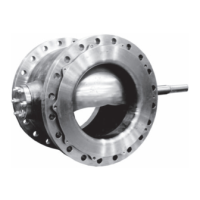
